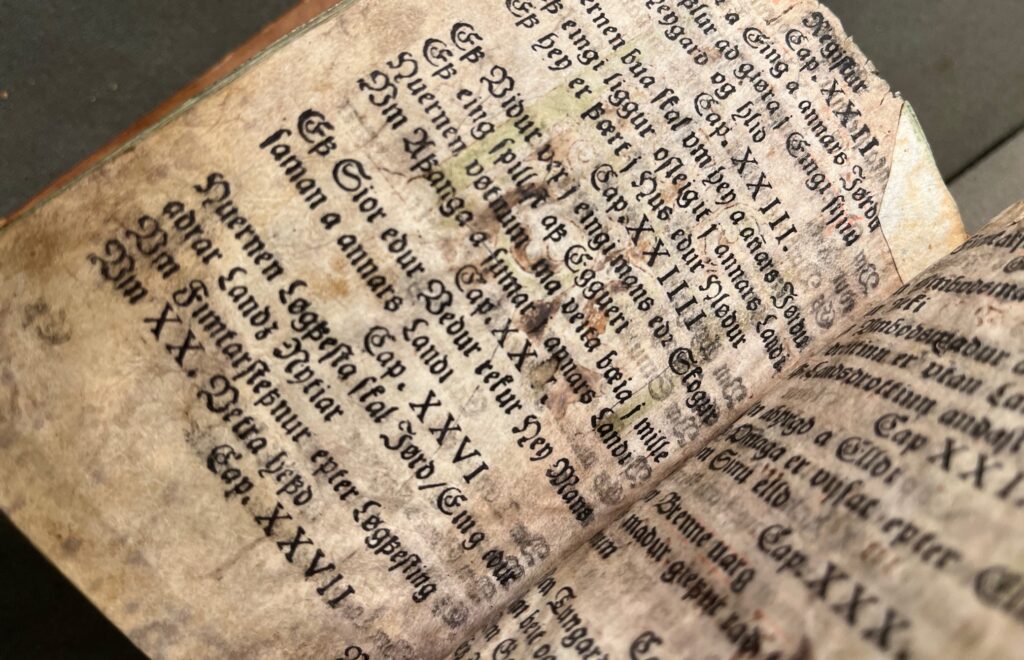Recycling is no new practice. It has been a common practise around the world for thousands of years. In my PhD project, I investigate how parchment from dismembered Latin books was recycled in various ways in Iceland after the introduction of the Reformation in 1550. These parchment fragments provide important insights in a lost chapter of Icelandic book history.
In medieval Europe, books were written on parchment. Parchment is a writing material made from animal skins which are prepared in a laborious and time-consuming process to make it more durable and better suited for writing. In Iceland, parchment was made exclusively from calf skin. To create even one single book, one would need to use the skins of dozens of calves. To make a book was a complex and expensive undertaking.

Because parchment is a very durable material, it is comparatively easy to reuse and recycle it. Due to poverty, it was very common to recycle used parchment in Iceland, even as early as the Middle Ages. Parchment recycling became even more widespread after the introduction of the Protestant Reformation in Iceland in 1550. This societal transformation made most of the old catholic books useless, – that is: their content. The material, the parchment, was highly valuable and it became an obvious choice to dismember the books and recycle their parchment for other purposes.
Parchment from dismembered books could be recycled in many ways, for instance to create tools or clothing. One famous example is a fragment which was made into a mitre (a type of headgear), which was worn by the Bishop of Skálholt in Southern Iceland.
Other noteworthy examples from Iceland include recycled parchment made into a sieve or material for chairs. In addition to tools and clothing, recycled parchment could be used as material for bookbinding for other books. Parchments were used as new book covers, as end leaves in the front or back to guard the book block or as reinforcements to strengthen the book spine.

Another way to use parchment to create new books is something called palimpsestation. A palimpsest is parchment where the original text was scraped or washed off so it could be reused as writing material. In Iceland, whole books were written or printed in palimpsest parchment. While writing on palimpsest parchment was widespread all over Europe, printing on palimpsest parchment was a local phenomenon unique to sixteenth-century Iceland (other places in Europe printed exclusively on new parchment).

Yet another way to recycle parchment was to cut off the empty margins which had not been written on before. These scraps of parchment could be used to write letters or charters. In one exceptional case, scraps were sewn together to create a completely new book.

Very few Latin books from medieval Iceland have survived. Because of their rarity, recycled parchment from dismembered Latin books is one of our most important sources for medieval Icelandic book history.
In my PhD project, I examine the surviving fragments of these old books, held by various libraries, archives and museums in Denmark, Iceland, Norway and Sweden. I investigate these rare parts of history, these different forms of parchment recycling, manuscript reuse and biblioclasm that lead to the destruction and fragmentation of the now lost Latin books. My aim is to create virtual reconstructions of some of the old fragments that have survived, to shed new light on historical society and culture.
Tom Lorenz is a PhD candidate at the Department of Language and Literature and the Centre for Medieval Studies.
The PhD project “Liturgical Fragments of Medieval Iceland” is supported by:
Kaia og Torfinn Tobiassens Fond
Sparebanken Midt-Norges gavefond til Norges teknisk-naturvitenskapelige universitet
The National PhD School Authoritative Texts and Their Receptions (ATTR)
Det Kongelige Norske Videnskabers Selskab


